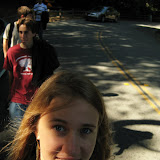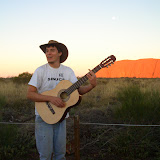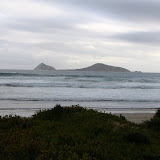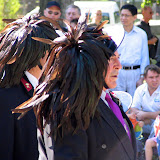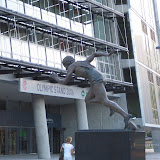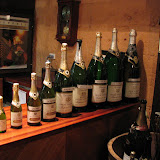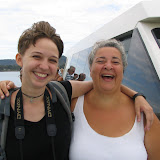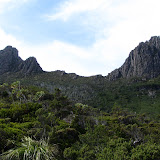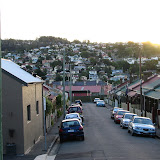Thursday, June 21, 2007
Update
Recently the Melbourne news has gone crazy about Christopher Hudson, a Hells Angels cyclist who murdered one and injured two others in the Central Business District a few days ago. I haven't paid much attention but there are plenty of articles. Meanwhile, it's winter here, which means I actually have to wear a coat sometimes. No colder than 40F ever. Most of the trees haven't even shed their leaves.
Anyway it's onto California after The Outback, then finally back to New York by July 10! It's been an incredible five months, full of traveling, thinking about traveling, studying instead of traveling, thinking about traveling instead of studying, spending money while traveling, etc. But I'm ready to stop studying and come back, especially since country queen Emmylou Harris doesn't perform in Melbourne.
Hope the summer is treating you all well. I'll try to write a little more about Melbourne, Uluru, and California before it's all over in a few weeks.
Wednesday, June 13, 2007
Waltzing Matilda
When Waltzing Matilda is sung seriously, the end of it gives you goosebumps.
Lyrics from article at Wikipedia.
Once a jolly swagman camped by a billabong,
Under the shade of a coolibah tree,
And he sang as he watched and waited 'til his billy boiled
"Who'll come a-Waltzing Matilda, with me?"
Waltzing Matilda, Waltzing Matilda
Who'll come a-Waltzing Matilda, with me
And he sang as he watched and waited 'til his billy boiled
"Who'll come a-Waltzing Matilda, with me?"
Down came a jumbuck to drink from the billabong,
Up jumped the swagman and grabbed him with glee,
And he sang as he stowed that jumbuck in his tucker bag,
"You'll come a-Waltzing Matilda, with me".
Waltzing Matilda, Waltzing Matilda
"You'll come a-Waltzing Matilda, with me"
And he sang as he stowed that jumbuck in his tucker bag,
"You'll come a-Waltzing Matilda, with me".
Up rode the squatter, mounted on his thoroughbred,
Down came the troopers, one, two, three,
"Where's that jolly jumbuck you've got in your tucker bag?"
"You'll come a-Waltzing Matilda, with me".
Waltzing Matilda, Waltzing Matilda
"You'll come a-Waltzing Matilda, with me"
"Where's that jolly jumbuck you've got in your tucker bag?",
"You'll come a-Waltzing Matilda, with me".
Up jumped the swagman, leapt into the billabong,
"You'll never catch me alive," said he,
And his ghost may be heard as you pass by the billabong,
"Who'll come a-Waltzing Matilda, with me?"
Waltzing Matilda, Waltzing Matilda
Who'll come a-Waltzing Matilda, with me
And his ghost may be heard as you pass by the billabong,
"Who'll come a-Waltzing Matilda, with me?"
Sunday, June 3, 2007
My Research, and Why Floyd Landis is an Ass
The Good: J.T. Brenna, master of the chemical universe, testifying at the Floyd Landis trial a couple weeks ago.

The Bad: Landis attorney Maurice Suh.

The Ugly: Floyd Landis, doped Tour de France winner and Lance wannabe.
 And here by “my research” I mean my professor's research, and by “Floyd Landis” I mean his lawyer, who tried to argue against my professor. This isn’t strictly about
And here by “my research” I mean my professor's research, and by “Floyd Landis” I mean his lawyer, who tried to argue against my professor. This isn’t strictly about
It’s always exciting when you find that your academic research has practical applications, so imagine the rush (yeah, I said rush) you get when you read about your research professor testifying at one of the biggest trials of the year. My professor back in
Chemists are control freaks who love manipulating substances. Separation science is the art of separating different chemicals. Sometimes you can use simple techniques to separate different materials—draining water from sand, for example, or letting the water evaporate, or boiling it. Separation becomes more difficult with chemicals of similar characteristics.
A GC with some attachments. This is what I've been spending my time with, instead of friends, for the past couple months.
Gas chromatography is able to separate very similar chemicals by sending them through a long, heated column that contains some stationary substance. Depending on that stationary substance, your chemicals will be attracted, repelled, or indifferent to it. If you were then to send a gas through the column and slowly raise the temperature to push the chemicals out, they would individually exit the column, depending on their attraction to the stationary substance. A “gas chromatograph” or “GC” is also equipped with a detector and timer that record the relative amount and time of these exiting chemicals via a series of peaks. Below is a sample GC readout, which shows a number of peaks, each corresponding to a different chemical. Those further to the right have exited the column later; those to the left exited the column sooner. Larger peaks indicate a larger amount of a chemical.
For a given column, stationary substance, and temperature program, you’ll find that each chemical takes a characteristic amount of time to travel through the column (“retention time”). You can put one chemical in the GC at a time, and determine its characteristic retention time. Later, when you have a sample of many unknown chemicals, you can put them in the GC and determine the chemical by its characteristic retention time.
Sounds pretty logical, right? Well, there’s a complication to this—sometimes completely different chemicals have identical retention times. Or sometimes their retention times overlap. In these cases, you haven’t separated your substances at all! You don’t know what chemical you’re looking at, or how much of the chemical your sample had. You won’t be able to convict Floyd Landis with this shoddy data!
That’s where two dimensional GC (“GCxGC”) can be useful. GCxGC uses TWO columns, one right after the other. The different columns contain different stationary substances, so they separate chemicals in different ways. If your chemicals have identical retention times with one column, they should be separated by the second column. Below is a sample readout from a GCxGC. Now, instead of looking straight at the peaks, we’re looking above them. The two axes correspond to the retention times on the two different columns.
Look at the peaks numbered 8 to 12. They would have been very close together, if not completely unseparated, on the first column. Fortunately for us the second column has separated them. Good thing, because now we have separated each chemical, and know how much of each we have.
Dr. Brenna wants to use a GCxGC to separate steroids. Last semester, he won a $1.3M grant from USADA to develop GCxGC steroid separation. My research professor in Melbourne, Dr. Marriott, is an expert on GCxGC, and is collaborating with Dr. Brenna on this steroid project. Their lab teams are currently looking at 27 steroids on the GCxGC and determining the correct column and temperature program to individually identify the steroids. They will create a library of characteristic retention times, and eventually be able to take urine samples, put them through the GCxGC, and determine both the identity and amount of these 27 steroids in a single sample of urine. Not only that, they’ll be able to do it much more precisely than anyone has done it before.
Think of how many times Lance Armstrong was accused of using steroids by a science lab, only to have the accusation retracted, based on insufficient evidence. Think of the current Landis trial. Hopefully Dr. Brenna will be able to provide the United States Anti-Doping Agency with a superior steroid testing protocol for the future.
What exactly were the separation scientists looking for in Floyd Landis’ samples? They were looking at his level of testosterone (a steroid). Everyone has some testosterone in their body naturally, and some have much more than others. The scientists look at the amount of testosterone relative to another steroid. They have found that this ratio has an upper limit naturally, and that this limit is only exceeded when one takes extra testosterone, which is precisely what happened in the case of Floyd Landis. Sorry, Floyd. You’re out. USADA says so, and J.T. Brenna agrees.
If you’re interested in a general article recapping the Landis trial, look here.
There are some articles that discuss Dr. Brenna, part in the trial, and his financial connection to USADA. Here and here.
If you’d like to read more about gas chromatography, you’re crazy. But here, here, and here you go.
Monday, May 28, 2007
Sydney

Another vacation come and gone! Boy,
Spent the last extended weekend with the two French fries, Agnes and Maud, in
Despite the city’s outward strength and wealth, it lacked some X factor or vibrancy that the French fries and I spent some time trying to identify. We decided that the lack of college students and children, the huge Central Business District and the monoculture of all the businessmen, and the large amount of tourists lend the city a different feel than
Not having enough time to do some proper research, I booked a hostel for the three of us in a place called “Kings Cross”, which sounded innocent enough. Actually, it’s
Sydney
The Opera House is by far the most stunning part of the city. It seemed like the three of us were always pulling our cameras out, putting them away, walking ten paces in any direction, and pulling them out again. The Opera House stands stoically in bad weather, shines in the sunlight, and glows at night. The “shells” that resemble sails or orange peels—depends on who you talk to—were thought to be impossible to build, but with enough money anything can happen. Construction went fourteen times over budget, but Sydneysiders now think it was worth it, and the rest of the world agrees.
Agnes and I felt quite overwhelmed with the beauty of the Opera House and let loose on the Monumental Steps.
I went on a tour inside, and found it to be disappointing overall compared to the exterior (except for the designer toilets, which were a religious experience). Most of the theaters and lounges look pretty typical, except for the largest Concert Hall, which seats less than three thousand people but has a huge organ (“Grand Organ” in these parts), leaving about four pipes per person.
Thought you might be interested to know that before the Opera House began construction in the 1960s, the site was being used as a tram shed. Back in those days
Went to
Because I don’t like
